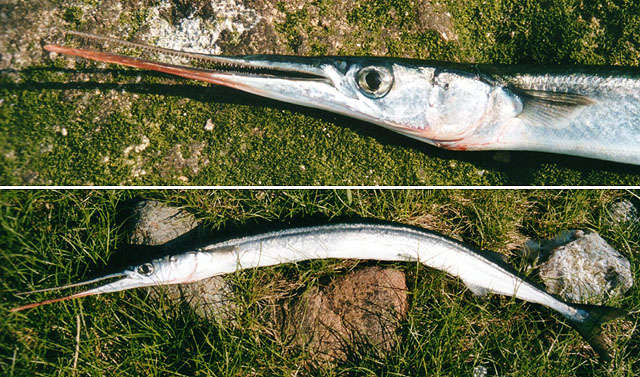| Belonidae (Needlefishes) |
| 104 cm TL (male/unsexed); max.weight: 1,418.0 g |
|
pelagic-oceanic; brackish; marine; depth range 2 - 22 m, oceanodromous |
| Eastern Atlantic and Mediterranean Sea. Three subspecies were recognized by Collette and Parin (1970, Ref. 34977) Belone belone belone (Linnaeus, 1761) (Northeast Atlantic); Belone belone euxini Günther, 1866 (Black Sea and Sea of Azov); Belone belone acus Risso, 1827 (Mediterranean Sea and adjacent parts of Atlantic Ocean, Madeira, Canary Islands, Azores, and south to Cape Verde (Ref. 50279); subspecies Belone belone gracilis Lowe, 1839 (France to the Canary Islands including the Mediterranean) in Collette & Parin, 1990 (Ref. 5757). |
|
Dorsal spines (total): 0-0; Dorsal soft rays (total): 16-20; Anal soft rays: 19-23. Jaw teeth comparatively large and widely spaced. Vertebrae 75-84. Vomerine teeth present at lengths greater than 20 cam. Lower jaw a little longer than upper jaw. Juveniles with greatly elongated jaw, without black posterior dorsal fin lobe. |
| Lives close to the surface and has a migratory pattern similar to the mackerel (Ref. 35388). Feeds on small fishes, particularly clupeids and Engraulis (in the Black Sea). Leaps out of the water when hooked. Oviparous (Ref. 205). Eggs may be found attached to objects in the water by tendrils on the egg's surface (Ref. 205). Utilized fresh and frozen; can be fried, broiled and baked (Ref. 9988). Minimum depth reported taken from Ref. 130219. |
|
Least Concern (LC); Date assessed: 10 July 2012 Ref. (130435)
|
| harmless |
Source and more info: www.fishbase.org. For personal, classroom, and other internal use only. Not for publication.
